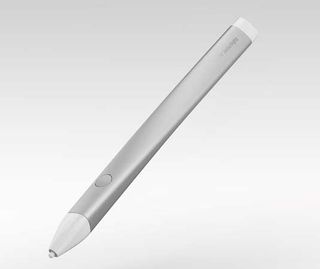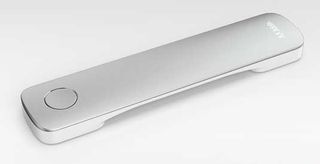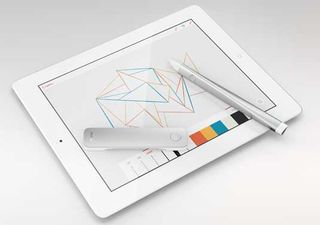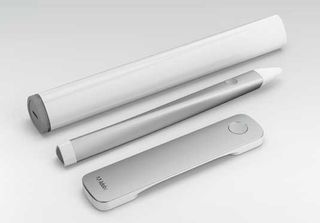Adobe: 'We want this device to define a generation'
Adobe's vice-president of experience design, Michael Gough, explains the thinking behind its new digital pen and digital ruler - and how this is only just the start of Adobe's hardware ambitions.

Pretty much everyone working in the creative industries knows that Adobe makes software. What you may not know is that it's now making hardware. But it doesn't want to be a hardware company. Although it is currently developing even more hardware products.
Confused? So were we, a little. So we had a word with Michael Gough, Adobe's vice-president of experience design, and the man behind its new cloud-based pen and digital ruler, to work out what was going on. And very quickly, all became clear...
Drawing devices
First, some background. The first product, Mighty, is a connected pen that's optimised for the iPad and is pressure sensitive, which helps it draw a natural and expressive line. Planned for release in the first half of 2014, it's wirelessly connected to Adobe's Creative Cloud, enabling you to pull up Kuler themes and access assets you've saved to the Cloud for reuse.

Gough, who describes himself as an "obsessive drawer" is pleased as punch that the pen's triangular. "That makes it much more ergonomic to use," he enthuses. "Pencils were originally triangular. They're octagonal because there's less waste; basically you can get more pencils out of a block of wood" - which is a consideration that clearly doesn't apply here.
"Furthermore, it twists, so that shape rests in your hand really comfortably," he adds. "We made it out of hydroformed aluminium, which is a technique used to make superlightweight bike parts, so it's pretty esoteric. And esoteric's always cool."
Old-school feel
The most important element, though, is the fine point that's been developed for Adobe by Adonit. "It creates a really nice, expressive line," Gough says, "where we're getting closer and closer to that feeling of pencil and paper."
And that feeling is, says Gough, the main inspiration behind the project. "Creatives, when they're working on their computers, might spend eight, nine, 10 hours a day in our software," he points out. "They only leave to do three things - go to the bathroom, to eat, and to think.
"That's always been perplexing. If you want to come up with a new idea, you grab a piece of paper and a pencil. But you don't do that in our tools. So what we've committed to doing is figuring how to do that digitally - so you get all the advantages of natural drawing, but in a digital environment."
One to rule them all
The second, complementary device to Mighty is Napoleon, which is a digital ruler (if you missed the pun the first time around don't worry, so did we). In a similar way, the Napoleon been designed to bring back the feeling of analogue drawing tools you probably used at school, such as the ruler, set square and triangle.

You use Napoleon in exactly the same way as those old school devices: run the pen along the side of it, above your tablet screen, and you'll get a perfect straight line or whatever you're trying to draw.
A couple of very nice devices, then, but why are they coming from Adobe, a company previously focused entirely on software like Photoshop, Illustrator and InDesign?
Changing audience
Gough explains that the company is trying to move in line with its audience. "Creative professionals are not relying on one or two monolithic tools any more," says Gough. "They're highly networked, they collaborate freely, they're less protective of their assets - they're highly digital citizens. So we're constantly trying to find new works to better meet the needs of this new generation.

"A new generation requires new tools, and that includes hardware," he continues. But he's keen to stress that "Adobe doesn't want to turn into a hardware company. We just want to make sure this next generation of hardware happens". In other words, Adobe wants to make the first leap so that others can follow.
To explain the distinction, Gough points to the example of Google. "When Google makes its first phone, they weren't thinking: 'We want to become a company that makes phones,'" he says. "But they wanted to make sure that first phone was made right - and that's the situation we're in here.
"Are we going to make a lot of money off of hardware? No." But that's not why they're doing it. Adobe wants new hardware developed that will make it easier for its customers to interact with its software - but who develops that hardware isn't important, as long as it works. "I'm often asked: 'What if Waccom make a cloud-connected pen? How do you feel about that?'," he asays. "Well, my response would be, 'Great!'"
You ain't seen nothing yet
Adobe is definitely planning more hardware projects following the launch of Mighty and Napoleon, Gough confirms. "We will continue to look for more and more natural ways for people to interact with software," he says. Anything specific? "There are a couple of new projects we're working on," he replies, "but neither of them have passed the 'taste test' yet".

But whatever new devices emerge, the important thing is that Adobe no longer sees hardware and software as separate entities, but two approaches to the same end that inform and influence each other. "These new interactions we're creating with hardware are inspiring us to think differently about the software we create," explains Gough.
New apps
One example is Parallel, a clever iOS app that allows you to create straight lines with a less-than steady hand. The app can also be programmed to create curves or indeed any kind of shape - and this led on to another idea, Contour, which is Gough characterises as "Kuler for shapes".
"With Contour you can photograph, say, a chair on a reasonable background it will extract the outline from that object," he explains. "And then you can publish that outline to Behance or Creative Cloud, and share it with your friends, or just use it yourself."
At a time when the move of its software to the Creative Cloud is still fresh and evolving, this new attention to hardware is another milestone in Adobe's bit for continuing dominance of the creative industries and beyond. Gough's concluding thought: "If tools really do define a generation, then there was certainly a Photoshop generation. I've heard people say that this is the Instagram generation. It'd be a real shame if it isn't an Adobe product that defines this next generation. Maybe we'll get lucky and it'll be known as the Mighty generation."
Words: Tom May
Liked this? Read these!
- Hands-on review: Adobe Photoshop CC
- Hands-on review: Adobe Illustrator CC
- Photoshop tips, tricks and fixes to try today
- Free Photoshop brushes every creative must have
- Free Photoshop actions to create stunning effects
- The best Photoshop plugins

Thank you for reading 5 articles this month* Join now for unlimited access
Enjoy your first month for just £1 / $1 / €1
*Read 5 free articles per month without a subscription

Join now for unlimited access
Try first month for just £1 / $1 / €1
Get the Creative Bloq Newsletter
Daily design news, reviews, how-tos and more, as picked by the editors.
The Creative Bloq team is made up of a group of design fans, and has changed and evolved since Creative Bloq began back in 2012. The current website team consists of eight full-time members of staff: Editor Georgia Coggan, Deputy Editor Rosie Hilder, Ecommerce Editor Beren Neale, Senior News Editor Daniel Piper, Editor, Digital Art and 3D Ian Dean, Tech Reviews Editor Erlingur Einarsson and Ecommerce Writer Beth Nicholls and Staff Writer Natalie Fear, as well as a roster of freelancers from around the world. The 3D World and ImagineFX magazine teams also pitch in, ensuring that content from 3D World and ImagineFX is represented on Creative Bloq.
